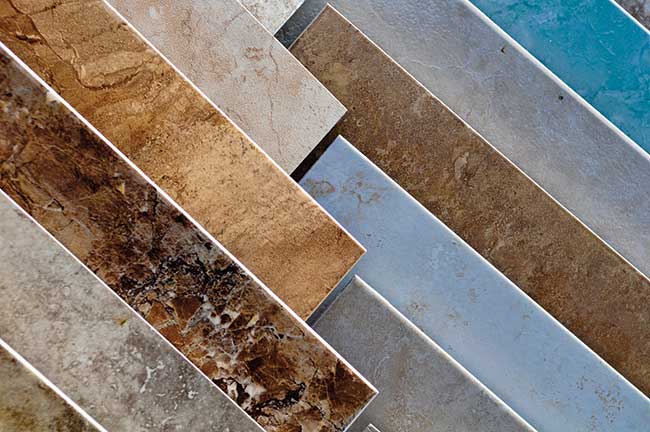Buying a home is one of the most significant financial decisions you’ll ever make, but the process...
What to Know about Stone Flooring Tiles - Infographic
Stone Struck
Natural stone — in statues, columns or under your feet — says permanence, stability and frequently luxury. And while you may not have a life-size Venus or Corinthian columns in your house, there’s every possibility you’ve at least thought about installing a beautiful natural stone floor.
From coloration to durability and maintenance, there are several factors to consider when choosing a stone, and each type has its own characteristics.

Limestone and Travertine...
...Are sedimentary rocks formed from materials such as seashells, silt, sand and clay. These stones are porous and can absorb water and stains. However, their texturally interesting appearance, workability and often warm colors have made them prized building materials for centuries. Both should be sealed when used as flooring. Limestone and travertine are well suited for dining rooms, bathrooms and hallways. Both make for hard surfaces with a soft, foot-pleasing feel that seems made for the ages.
Quick Tip
Save Extras!
When installing stone tiles, purchase extras to use as replacements should tiles become cracked, scratched or stained. Stone flooring tiles vary widely in color and pattern. Ordering months or years later can make finding a good match difficult, if not impossible.
Marble
is limestone transformed by pressure and heat from a sedimentary rock into a metamorphic one. Known for its distinctive veining and elegant appearance, marble makes a wonderful choice for foyers, living rooms and dining rooms. It is susceptible to stains and not an optimum choice for kitchens. According to the World Floor Covering Association, green and black marbles can deteriorate when wet and should not be used in bathrooms.
Slate
A harder surface than marble, Slate is related to coal and is a metamorphic rock that was formed when clay sediments were subjected to heat and pressure. Slate surfaces will remain slightly uneven, but are extremely durable. Slate requires less care than other stones and won’t be slippery underfoot. Rustic family rooms floored in purple, black, blue or gray slate look authentic from the beginning.
Granite
The hardest flooring stone, is an igneous rock that comes directly from the earth’s magma via a volcanic event. Due to its extraordinary hardness, granite requires special equipment to cut and shape — not a job for do-it-yourselfers. It is resistant to heat, stains and water. Once polished it requires minimal care to hold its shine. Tough granite tile is perfect for high use areas, or most anywhere else.
Stone Floor Cleaning Basics
Just like a pet — or maybe even a child — anything natural is going to take some work to make it behave and turn out right. And so it is with a natural stone floor. Here are some do’s and dont’s:
- First and foremost: Get rid of grit! Dirt and sand are abrasive and can mar your floor with scratches or by slowly grinding away at its polish. Drag out the vacuum or a broom if you feel any tiny grains underfoot.
- Damp mopping is recommended for stone floors. For general cleaning, use a pH-neutral, stone-safe soap rather than detergents or cleaners made for porcelain or ceramic tile. A flooring dealer can recommend specific products.
- Say “no” to harsh chemical cleaners. Say “no” to vinegars or other acids. Say “never” to abrasives. And don’t scrub at spills, but instead blot them up with a soft rag or a cotton mop.
Other Options
Ceramics step up

What kind of flooring is hard like a rock and often looks like stone but isn’t? That’s an easy one: ceramic tile.
With products that are more affordable than stone and generally easier to install, the ceramic category includes both porcelain and non-porcelain tiles. The non-porcelain type is popularly known as simply “ceramic.”
Both ceramic and porcelain tiles are made of clay or a clay-containing mix, but porcelain tiles, made of finer textured porcelain clay, are denser and harder — touted as up to 30 percent harder than granite. Porcelain tiles are also more impervious to water than non-porcelain tiles. Being less porous, they are trickier to install and care must be taken to get a good bond.
Unlike standard ceramics, porcelain tiles also can be produced with color running all the way through, so that a chip shows no telltale white. These are called full body porcelain tiles as opposed to glazed porcelain tiles. Glazed porcelains are available in a wider range of patterns and colors. Either type of porcelain commonly costs more than non-porcelain ceramic.
Porcelain and non-porcelain tiles come in a wide variety of beautiful finishes, and can look very much like natural stones such as marble and slate. What they lack is the natural and seemingly endless variation of pattern found in natural stone, where one piece will never be an exact copy of another.
Also unlike stone, though, ceramics are virtually impervious to household cleaning chemicals and food spills. The right tile, properly installed on a well-prepared subfloor, should provide a hard-wearing, low-maintenance surface for decades.
Before buying a glazed tile for flooring, check the product’s PEI wear rating. The Porcelain Enamel Institute scale runs from 1 to 5 and rates the ability of a tile’s glaze to stand up to abrasion, with a higher number indicating a more durable finish. For floors, Home Depot suggests using a tile rated as PEI 3 or up.
Learn something new? Want to pass an idea to a friend?
Share the knowledge with your network! ![]()

